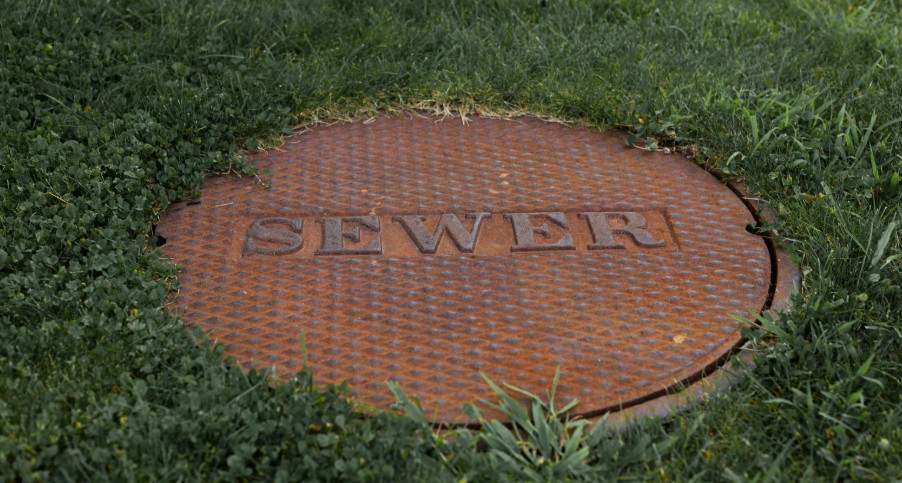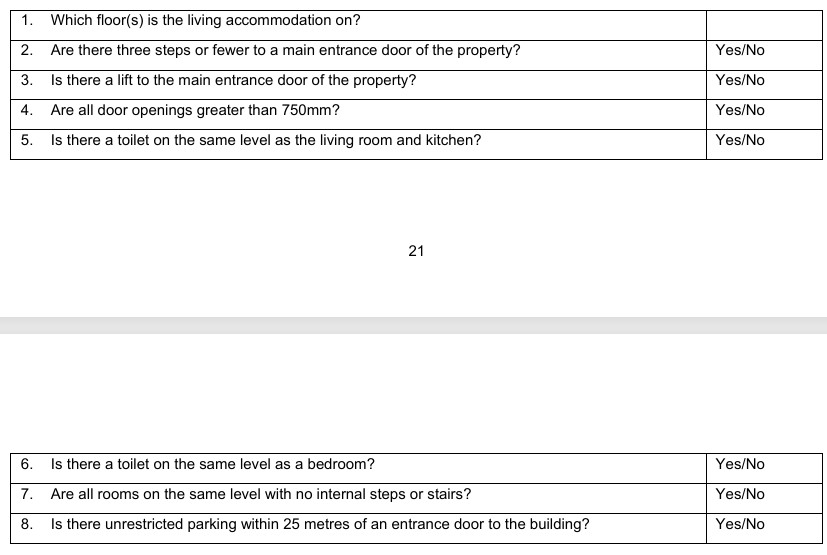Key Changes in the Draft Standard
1) Drains, inspection chambers & covers
- Current Level 2 (in force): lift accessible inspection chamber covers to drains/septic tanks (safe to do so, no damage). No requirement to run water.
- Draft Level 2 (red-line): lift all loose covers (gullies, inspection chambers, etc.). Do not unscrew, ease stuck/rusted covers, or run water. “Reasonable attempts to ease/unscrew” moves to Level 3.

Impact
For surveyors: Level 2 remains non-intrusive - you’ll still lift only what is loose and safe. If a client expects you to “try to free a stuck manhole,” that is now explicitly Level 3. Tighten your ToE and on-site script to manage expectations.
For clients: You should still get a look into any chamber with a loose cover, but you shouldn’t expect tools/effort to free stuck or screwed covers unless you’ve commissioned a Level 3.
2) Ventilation (fans, trickle vents)
- Current Level 2: only visual inspection of services; operating fans appears at Level 3 (“operate an identified sample of lights and extractor fans”). RICS
- Draft Level 2: check operation of mechanical extract systems in wet areas and a sample of trickle ventilators.

Impact
- For surveyors: small but real scope uplift - plan to switch on bathroom/kitchen extract fans and note if trickle vents open/close. This adds a couple of minutes per wet room and pushes you to carry a simple method to confirm operation (visual/sound/air movement), but it’s still a “check”, not a test. The draft also sharpens the distinction between a check and a test.
- For clients: clearer feedback on whether everyday ventilation actually works, which ties directly into condensation/mould risk and energy performance outcomes.
3) Windows & doors sampling
- Current Level 2: open one on each elevation and one of each type where there’s variety.
- Draft Level 2: check a reasonable sample of windows and doors “to confirm a professional judgement.”

Impact:
- For surveyors: more outcome-based than prescriptive. Your sample should still be representative (elevations/types), but you can adjust sampling when access is constrained. Record the basis of your sample in your site notes for defensibility.
- For clients: the report should remain representative while being more transparent about limitations and professional judgement.
4) Floors & sub-floors; roof spaces (mostly steady-state)
- Floors - Level 2: both documents allow inverted head-and-shoulders through unfixed hatches/panels where safe. No entry into the sub-floor void. (No substantive L2 change.)
- Roof space — Level 2: enter and visually inspect where safe; thick insulation may limit traversal (message consistent across versions). (No substantive L2 change.)
Impact
- For surveyors: as you were - risk-based access, don’t move insulation/stored items at L2.
- For clients: still a visual roof-void inspection, limited by safety/access/insulation.
5) Energy efficiency & EPC duties at Level 2
- What the current standard says (L2) - Energy matters section: at Level 2, “checks should be made for any obvious discrepancies between the EPC and the subject property and the implications explained to the client.”
- What the draft says (L2) - Energy matters (re-ordered/clarified): at Level 2, explain any obvious discrepancies between the EPC and the property and the implications for the client. The draft also flags the changing landscape (e.g., the Home Energy Model (HEM) replacing SAP/RdSAP) and the need for broader competence regarding energy measures and new tech.

Impact
- For surveyors: the duty is essentially the same at L2 - spot and explain obvious EPC discrepancies (e.g., EPC says solid walls but you observe cavity; EPC assumes single glazing but you observe double; EPC recommendations unsuitable for a traditional solid-walled home).
However, the draft places stronger emphasis on competence around energy-efficiency context and terminology (e.g., HEM). If the client wants retrofit advice beyond L2 scope, signpost a separate instruction under the RICS Residential Retrofit Standard or to an appropriately qualified professional (e.g., Retrofit Assessor/Coordinator under PAS 2035).
- For clients: you’ll still get commentary on EPC mismatches and what that means for comfort, cost and planning. Detailed retrofit design/advice remains a separate service.
Step-by-step: how a Level-2 surveyor should handle EPC/energy (draft-aligned, but valid now)
- 1. Before the visit: obtain and read the EPC; note construction/assumptions/recommendations that look “off” for age/type (e.g., internal vs external insulation for pre-1919).
- 2. On site: confirm obvious identifiers (wall type, glazing, heating/controls, ventilation). At L2, check fans run in wet rooms and a sample of trickle vents (per draft), and note any ventilation deficits linked to condensation risk.
- In the report: Flag any obvious EPC discrepancies and explain implications (comfort, moisture risk, cost, consents). Avoid prescriptive retrofit design at L2; instead, signpost to RICS Residential Retrofit Standard services or a PAS 2035 pathway if the client wants to proceed.
Where BRE guidance and the Joint Position Statement fit
When you comment on EPC discrepancies or discuss energy-efficiency suitability/risks (even at L2), you should anchor your reasoning to recognised technical and moisture-risk guidance:
- Joint Position Statement (RICS / Historic England / PCA): Investigation of moisture and its effects on traditional buildings – Principles and competencies (Sept 2022).
Why it matters: it sets the best-practice diagnostic mindset for moisture-first, fabric-first thinking - crucial when explaining why certain EPC recommendations may be unsuitable or risky for traditional construction without a whole-building approach.
- BRE BR 262 – Thermal insulation: avoiding risks (5th ed.)
Why it matters: practical do’s/don’ts for insulation and cold-bridge/moisture interactions - invaluable context when explaining risks in solid-walled/complex dwellings.
- BRE BR 443 – Conventions for U-value calculations
Why it matters: underpins how thermal performance is assessed; helps you explain, at a high level, why an EPC/HEM estimate may not reflect as-found details. (You’re not calculating at L2, but you’re aligning your commentary with how it should be calculated.)
- RICS Residential Retrofit Standard (effective 31 Oct 2024)
Why it matters: if a client wants to move beyond L2 commentary into advice/design/coordination, this is the framework you (or a colleague) should work under.
6) Damp & Mould: How to Use the BRE Guidance and JPS
At Level 2
- Surveyors are expected to identify likely causes of dampness based on inspection and context, not exhaustive investigation.
Example approach:
1. Record evidence: staining, mould pattern, ventilation provision.
2. Use JPS (2022) - confirm whether evidence fits condensation, penetration, or rising damp.
3. Apply BRE Digest 245 (2013) - only if further testing is required, explain that this lies outside a Level 2 inspection.
Example report wording: “There is evidence consistent with condensation-related mould in bedrooms, most likely arising from limited ventilation. While no building defect was found, monitoring and improvement of ventilation should be considered.”
At Level 3:
- Deeper use of BRE techniques, e.g. moisture profiling or salt testing, may be appropriate.
- Reports can specify intrusive tests and propose long-term remedial measures.
7) Accessibility
The draft Home Survey Standard introduces a clearer requirement for surveyors to consider basic accessibility information within a Level 2 report. While it is explicit that a Home Survey is not a disability access audit or assessment – and surveyors are not expected to evaluate a client’s specific disability needs – there is now a formalised obligation to include a set of standardised questions.
The surveyor must include the table (derived from the Housing (Scotland) Act 2006 (Prescribed Documents) Regulations 2008) in their report, answering the following questions:

What does this mean for Level 2 surveys?
- Clarification, not expansion of scope: Surveyors are not expected to carry out measurements beyond simple checks (e.g. confirming whether a doorway appears wider than 750mm, or whether steps exist at the main entrance). This remains within the Level 2 remit of a visual inspection.
- Standardised reporting: The inclusion of the prescribed table removes ambiguity. Clients will receive clear, consistent accessibility data across all Level 2 surveys.
- Avoiding liability creep: By explicitly stating that the survey is not an access audit, the draft standard protects surveyors from being held responsible for detailed accessibility advice.
Impact on surveyors and clients
Surveyors: This will add a small amount of extra site time (5–10 minutes), but largely involves structured observation and record-keeping. It also creates an opportunity to flag where limitations apply (e.g. “unable to confirm doorway width without measurement”).
Clients: The benefit is significant – particularly for those with mobility needs or planning for future-proofing. It also aligns with increasing consumer demand for homes that support ageing in place.
Reflection – is this a “Level 2+”?
Although the draft explicitly states that accessibility information does not turn the Home Survey into a disability access audit, in practice this section may feel like an incremental widening of scope. By introducing a structured table, surveyors are being asked to provide a degree of standardised data that goes beyond the traditional narrative style of Level 2.
For most surveyors, this is manageable and sensible – many already cover such issues informally in client conversations. However, the inclusion of the prescribed table raises the bar for consistency, and adds to the cumulative list of small additional tasks within the draft standard. As with the damp and mould provisions, this may not fundamentally change what is inspected, but it does alter how it must be recorded.
For clients, this is likely to be welcomed as a value-adding change. For surveyors, it is another reminder that the time allocated for a Level 2 survey needs to be realistic: these incremental additions reinforce that a well-prepared, properly delivered survey cannot be compressed into a short site visit and quick report turnaround.
This requirement reflects wider demographic trends: with an ageing population and around 1 in 5 people in the UK living with some form of disability (Equality Act 2010; RICS, 2025 draft), accessibility has become an increasingly important factor in housing decisions.
8) AI (Artificial Intelligence) in Survey Reporting
The draft standard recognises that surveyors may use AI/tech. Here’s how you could phrase it (transparent, but not undermining professional accountability). The RICS guidance on ethics also requires transparency in professional judgement.
- Acceptable: Using AI tools for proofreading, grammar checking, or readability analysis.
- Not acceptable: Substituting professional judgement with AI outputs.
- Recommended report wording could include:
“Parts of this report have been prepared using digital tools, including software to assist with grammar, readability and consistency. All findings, interpretations and professional opinions remain the responsibility of the surveyor, who has verified the accuracy and appropriateness of the final content.”
9) Client Satisfaction and Demand for Surveys
Current Uptake
- Research suggests that 10 - 20% of buyers commission their own RICS home survey.
- Many first-time buyers rely solely on the mortgage valuation, mistakenly thinking it is a survey.
What Home Buyers Value
- Liked: Plain English, clarity on “what to do next”, photographs. Reassurance and technical expertise. (MoneySavingExpert, 2024 forums).
- Disliked: Vague disclaimers, reports that list defects but don’t explain solutions, “copy-paste” feel (Mumsnet threads, 2024).
Anticipated impact of the proposed changes on the customer experience:
- The draft standard’s stronger emphasis on energy efficiency, ventilation, and actionable advice is likely to increase satisfaction and make surveys more obviously valuable.
- However, the additional work burden may push fees higher - which could initially reduce uptake among cost-sensitive buyers.
10) Costs and Realistic Time
Time Impact: The End of 10 Surveys a Week? This model has long been a concern for diligent surveyors, although RICS has never set a limit on how many surveys can reasonably be carried out in any given day or week, with quality being very much self-regulated, save for formal complaints to RICS.
- On-site: RICS guidance (2021) suggests ~2 hours for a standard Level 2. With additional duties (fan and trickle vent checks, representative samples, EPC analysis), expect an extra 15–30 minutes.
- Preparation & preambles: More EPC checking, legislation updates, and cross-referencing retrofit standards.
- Write-up & QA: Greater emphasis on energy efficiency and ventilation adds complexity. AI can save time on readability but not on technical reasoning.
- Client communication: Stronger expectations around pre-instruction advice and post-survey explanations.
Reality check: A thorough Level 2 will reasonably take half a day minimum including site visit, preamble, write-up, and client communication. A Level 3 can take a full day or more. This perhaps marks the decline of the £250, high-volume survey model. Instead, surveyors will provide fewer but higher-quality surveys, with fees reflecting the increased time and expertise.
- For buyers:
If your property is anything larger or more complex than a small, uncomplicated flat, a survey fee below £400–£450 is unlikely to provide good value. At that level, the surveyor may not have enough funded time to properly inspect, reflect, and write a useful report. Expect a lot of caveats and further recommendations.
- For surveyors:
If you are regularly delivering more than 7 surveys per week, the chances are you are not giving clients sufficient time or value, and you may be exposing yourself to professional risk.
(7 surveys × ~ 6 hrs = 42 hrs, before travel/admin, which is effectively a full-time load with little margin for QA or CPD.)
Required Time (Good Practice)
- Preamble & desktop checks: 1–2 hrs
- On-site inspection: 2–3 hrs
- Report writing: 2–3 hrs
- Client call / reflection: 0.5–1 hr
Total: 5.5–9 hrs
Thus: a £250 - 300 fee is only sustainable if corners are cut, particularly for employed surveyors within firms. Realistic sustainable fees are higher.
Conclusions
The RICS draft home survey standard (2025), assuming the consultation doesn’t drastically alter the proposals, will almost certainly improve the clarity, usefulness, and accountability of Level 2 reports. Clients will benefit from more meaningful insights into drainage, energy, and damp. However, the added work burden makes low-fee surveys (£250–£350) increasingly unsustainable, especially once employment or self-employment overheads are factored in. Firms offering these kinds of surveys will either increase costs, or continue to offer poor quality reporting, contributing to negative consumer perception of the profession. Professional surveyors offering good quality services may find margins decreasing, or may make use of technology to find efficiencies to keep costs reasonable.
The most likely impact:
- Possible slight reduction in survey uptake among the most cost-sensitive buyers.
- Improved satisfaction among those commissioning properly resourced surveys.
- Commercial pressure on firms and individuals who compete primarily on price rather than quality.

References
- Artema (2024) True cost of an employee calculator. Available at: https://www.artema.co.uk/true-cost-of-an-employee-calculator/ (Accessed: 1 September 2025).
- Boundless (2025) Employment cost calculator for the UK. Available at: https://boundlesshq.com/guides/united-kingdom/employment-cost-calculator/ (Accessed: 1 September 2025).
- BRE (2013) Digest 245: Rising damp in walls – diagnosis and treatment. Watford: Building Research Establishment.
- FP Advance (2014) Overhead percentage benchmarks. Available at: https://fpadvance.com/overhead_percentage/ (Accessed: 1 September 2025).
- HomeOwners Alliance (2023) How many people get a survey when buying a house?. Available at: https://hoa.org.uk (Accessed: 1 September 2025).
- MoneySavingExpert Forums (2024) Home survey experiences [Forum posts]. Available at: https://forums.moneysavingexpert.com (Accessed: 1 September 2025).
- Mumsnet (2024) House surveys – worth it? [Forum posts]. Available at: https://www.mumsnet.com (Accessed: 1 September 2025).
- RICS, Historic England, Property Care Association (2022) Joint Position Statement on the investigation of moisture and its effects on traditional buildings. London: RICS.
- RICS (2025, Draft) Home Survey Standard (Consultation Draft). London: Royal Institution of Chartered Surveyors.